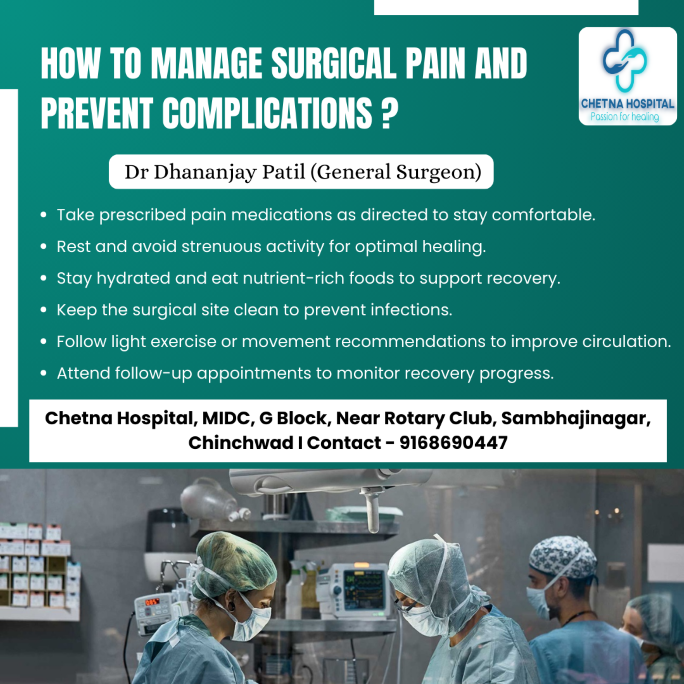Undergoing surgery is a significant life event, often associated with anxiety about pain and potential complications. Proper pain management and proactive complication prevention are critical to a successful recovery and improving overall patient outcomes. This blog explores effective strategies for managing surgical pain and minimizing the risks of complications, ensuring a smoother post-operative journey.
Understanding Surgical Pain
Types of Surgical Pain
Surgical pain arises primarily from tissue damage during the procedure and can vary depending on factors such as the surgery’s type, duration, and complexity. Common categories include:
- Acute Pain: Immediate, sharp pain post-surgery, typically subsiding as the body heals.
- Chronic Pain: Long-term discomfort lasting months or even years after surgery.
- Neuropathic Pain: Pain caused by nerve damage during the procedure, often described as burning or tingling.
Why Pain Management Matters
Effective pain management is more than alleviating discomfort. Uncontrolled pain can:
- Delay recovery by limiting mobility.
- Increase stress levels, leading to higher cortisol production, which impairs healing.
- Result in chronic pain if not addressed promptly.
Strategies for Pain Management
Pre-operative Planning
A comprehensive pre-operative plan includes educating patients about what to expect, addressing concerns, and setting realistic pain management goals. Discuss the following aspects with your surgeon and anesthesiologist:
- Pain Tolerance: Assess individual pain thresholds to tailor medications.
- Medical History: Review prior reactions to anesthesia or pain medications.
- Pain Management Plan: Develop a strategy including medications, physical therapies, and alternative methods.
Post-operative Pain Control
1. Medications
- Opioids: Prescribed for severe pain, they should be used with caution due to risks of dependency and side effects.
- Non-Opioid Analgesics: Medications like acetaminophen and NSAIDs (e.g., ibuprofen) are effective for mild to moderate pain.
- Local Anesthetics: Regional blocks or injections at the surgical site can provide targeted relief.
2. Non-Pharmacological Methods
- Physical Therapy: Gentle movement and stretching enhance circulation, reduce stiffness, and alleviate pain.
- Cold and Heat Therapy: Alternating cold packs and heat pads can reduce swelling and soothe muscle soreness.
- Relaxation Techniques: Practices like deep breathing, guided imagery, and mindfulness can lower pain perception.
Role of Nutrition
Nutritional support can significantly affect pain levels and healing. A diet rich in protein, omega-3 fatty acids, and vitamins (like A, C, and E) promotes tissue repair and reduces inflammation.
Preventing Post-operative Complications
Common Surgical Complications
- Infections: Can occur at the surgical site or systemically, leading to fever and discharge.
- Deep Vein Thrombosis (DVT): Blood clots forming in veins, often in the legs, pose life-threatening risks if they migrate to the lungs.
- Pulmonary Issues: Respiratory complications such as pneumonia may arise from reduced activity post-surgery.
- Scar Tissue Formation: Overgrowth of fibrous tissue can cause stiffness or discomfort around the surgical site.
- Delayed Wound Healing: Caused by factors like poor blood supply, infections, or inadequate nutrition.
Key Prevention Strategies
1. Hygiene and Wound Care
- Follow your surgeon’s instructions for cleaning and dressing the wound.
- Keep the surgical site dry and monitor for signs of infection (e.g., redness, swelling, or discharge).
2. Mobility and Exercise
- Begin gentle movements as recommended to improve circulation and reduce clot risks.
- Gradually resume daily activities to regain strength and flexibility.
3. Medications
- Take prescribed antibiotics to prevent infections.
- Use anticoagulants (blood thinners) as directed to reduce the likelihood of DVT.
4. Monitor for Early Warning Signs
- Fever, unusual swelling, or persistent pain should be reported immediately.
- Breathlessness or chest pain may indicate pulmonary embolism and requires urgent care.
5. Nutrition and Hydration
- Stay hydrated to support metabolic functions.
- Consume balanced meals to provide essential nutrients for recovery.
Advanced Techniques and Innovations
1. Enhanced Recovery After Surgery (ERAS)
ERAS protocols focus on a multidisciplinary approach involving optimized anesthesia, early mobility, and nutritional interventions to enhance outcomes.
2. Minimally Invasive Surgery
Laparoscopic and robotic-assisted techniques reduce tissue damage, resulting in less pain and faster recovery.
3. Telemedicine Follow-ups
Virtual consultations allow real-time monitoring and early intervention for complications, especially for patients in remote areas.
Conclusion
Surgical pain and complications, while challenging, can be effectively managed with a combination of medical, physical, and lifestyle strategies. Partnering with healthcare providers to develop a personalized recovery plan is critical. Staying informed, adhering to recommendations, and promptly addressing any concerns ensure a smoother and safer post-surgery experience. By prioritizing these strategies, patients can confidently navigate their journey towards optimal health and well-being.
For Consultation Contact us on 8390861787
Website – www.chetnahospital.co.in
Address – Chetna Hospital, Sambhajinagar, MIDC, G Block, Near Rotary Club, Chinchwad 411019
.
.
.
#pune#pcmc#chinchwad#hospital#medical#medicalservices#health#healthcare#surgery#generalsurgery#medicalprocedure#generalsurgeon#generalsurgeoninchinchwad













